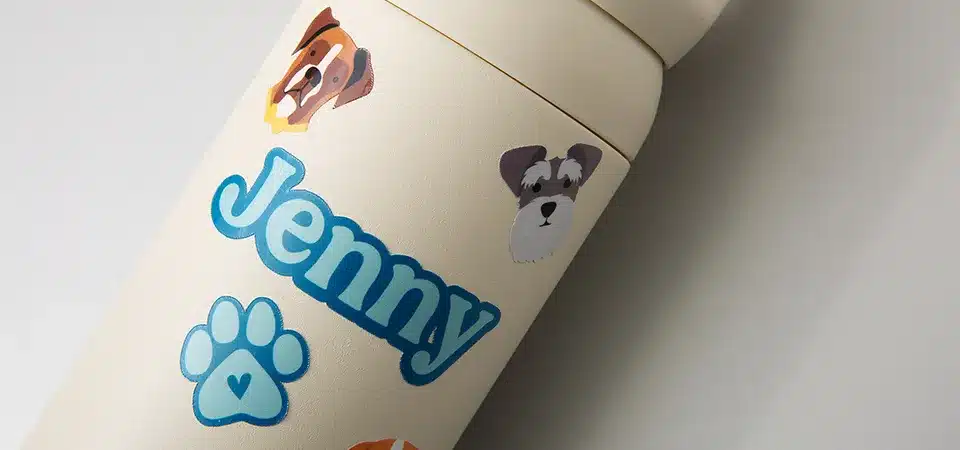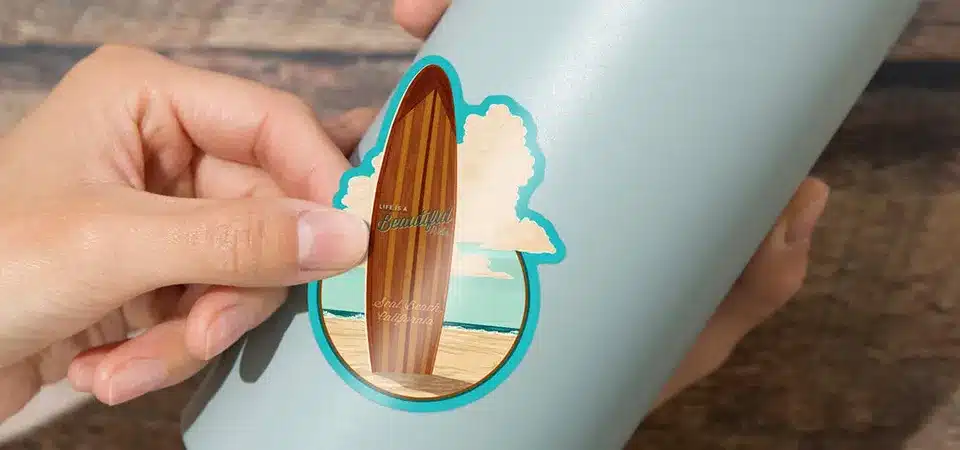Your vinyl stickers look great on your new plastic gear, but you're worried they'll peel off or fade quickly. You need a way to protect your design.
To seal vinyl stickers on plastic, first clean the surface with isopropyl alcohol. Apply the sticker and smooth out any bubbles. Then, spray with a clear, UV-resistant acrylic or polyurethane sealer. This creates a durable, waterproof layer that prevents peeling and fading.
As someone who prints stickers for all kinds of tough applications, from dirt bikes to outdoor equipment, I know that just sticking it on often isn't enough for plastic surfaces. Plastic is a tricky material; it can be flexible and often has oils from the manufacturing process that resist even the best adhesives. Sealing is the professional step that makes your stickers last and look amazing for years. Let's walk through why this step is so important and exactly how you can do it right at home.
Why Should You Bother Sealing Vinyl Stickers Anyway?
You put a beautiful sticker on your favorite water bottle or laptop case. But a week later, the edges are lifting and the vibrant colors look dull. It's frustrating.
You should seal vinyl stickers to create a protective shield against moisture, UV rays, and physical scratches. This simple step prevents peeling corners, color fading, and damage. It dramatically increases the sticker's lifespan, keeping it looking great for years.
I once had a client who owned a small kayak rental business. He ordered hundreds of beautiful, colorful logo stickers to put on his plastic kayaks and paddles. The first batch he applied looked amazing, but after just a few weeks on the water, they were a mess. The sun had faded them, and water had gotten under the edges, causing them to peel. He was so disappointed. For his next order, I showed him how to seal them. It was a game-changer. The sealed stickers took a beating all summer long and still looked brand new. This experience showed me that for some plastics, sealing isn't just an option; it's a requirement.
Here's a breakdown of the main threats to your stickers and how sealing stops them.
| Threat | How It Damages Unsealed Stickers | How Sealing Protects It |
|---|---|---|
| Moisture & Water | Water seeps under the edges, attacks the adhesive, and makes it peel. | The sealer creates a fully waterproof barrier. Water can't get to the sticker. |
| UV Sunlight | The sun's rays break down the ink, making bright colors look faded. | Sealers with UV protection act like sunscreen for your sticker to keep it vibrant. |
| Abrasion & Scratches | Constant rubbing and bumps wear away the vinyl surface and ink. | The hard, clear topcoat takes the damage, protecting the sticker design underneath. |
What Is the Best Way to Seal Vinyl Stickers on Plastic Surfaces?
You're ready to seal your sticker, but you're nervous about messing it up. Using the wrong product or a bad technique can ruin your project with drips or a cloudy finish.
The best method is a simple four-step process. First, choose a polyurethane spray. Second, thoroughly clean the plastic. Third, carefully apply the sticker. Finally, apply the sealer in several light, even coats to build a protective, clear finish.
Getting a perfect, factory-like finish is easier than you think. It's all about being patient and following the steps correctly. Over the years, I've seen what works and what doesn't. Rushing the process is the number one cause of problems. A little extra time spent on preparation will give you a result you can be proud of. Here is the exact process I recommend to all my clients for sealing stickers on an outdoor cooler, a helmet, a water bottle, or any other plastic item.
1. Use the Right Polyurethane Spray or Sealer
The product you choose is very important. You need a sealer that is clear, won't turn yellow in the sun, and is safe for both plastic and vinyl. I strongly recommend using a spray sealer over a brush-on type. Sprays give you a much smoother and more even finish, without any brush strokes. Look for a can of clear acrylic or polyurethane spray at your local hardware store. Brands like Krylon or Rust-Oleum make excellent "Crystal Clear" or "UV-Resistant Clear" sprays. Make sure you choose a gloss or matte finish that matches the look you want. Gloss will make the colors pop, while matte provides a more subtle, modern look.
2. Clean the Plastic Surface
This step is the most important for good adhesion. Plastic surfaces often have oils, dust, or mold-release agents from the factory that you can't even see. These residues will prevent your sticker from sticking properly. To clean it, take a lint-free cloth and some isopropyl alcohol (rubbing alcohol). Pour a little alcohol on the cloth, not directly on the plastic. Wipe the entire surface where the sticker will go. A pro tip I always give my clients is to wipe in one single direction. Wiping in circles can sometimes just smear the oils around. Wiping in one direction lifts them off completely. Let the surface air dry for a few minutes. It shouldn't take long.
3. Apply the Sticker Firmly
Now it's time to place your sticker. For small stickers, you can just peel and stick. But for larger ones, I recommend the "hinge method" to avoid frustrating air bubbles. Place the sticker where you want it and use a small piece of masking tape to tape down the middle of it, creating a hinge. Then, peel one half of the backing off, cut it away, and use a credit card or a squeegee to smooth that half down from the center hinge outwards. Then, remove the tape, lift the other half, peel the rest of the backing off, and smooth it down from the center out. Once the sticker is on, use your squeegee to press down firmly all over the sticker, especially the edges.
4. Seal the Stickers
This is the final step. Do this in a well-ventilated area, preferably outside. Shake the spray can very well for at least a minute. Hold the can about 10-12 inches away from the surface. Spray in light, even strokes, going back and forth. It's much better to apply several thin coats than one thick, heavy coat. A heavy coat will drip and look messy. Apply the first light coat over the entire sticker and the plastic area right around it. Let it dry for about 15-20 minutes. Then, come back and apply a second coat. For items that will see a lot of wear and tear, like a cooler or helmet, I recommend a third coat. Let the item cure completely for at least 24 hours before you use it.
Conclusion
Sealing your vinyl stickers on plastic is easy. Just clean the surface, apply the sticker, and use a clear spray sealer to protect it for years.










